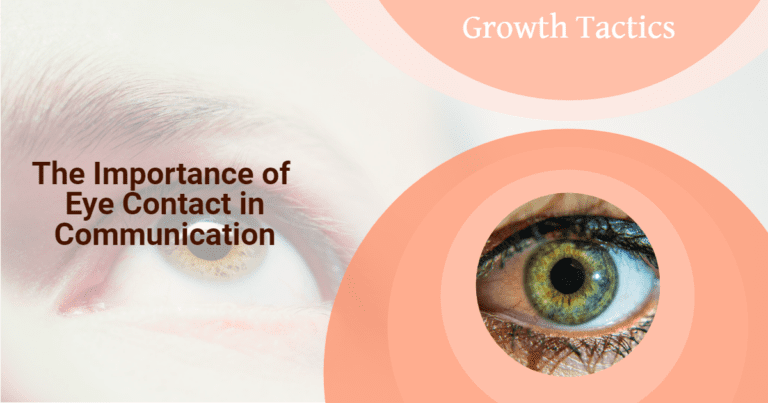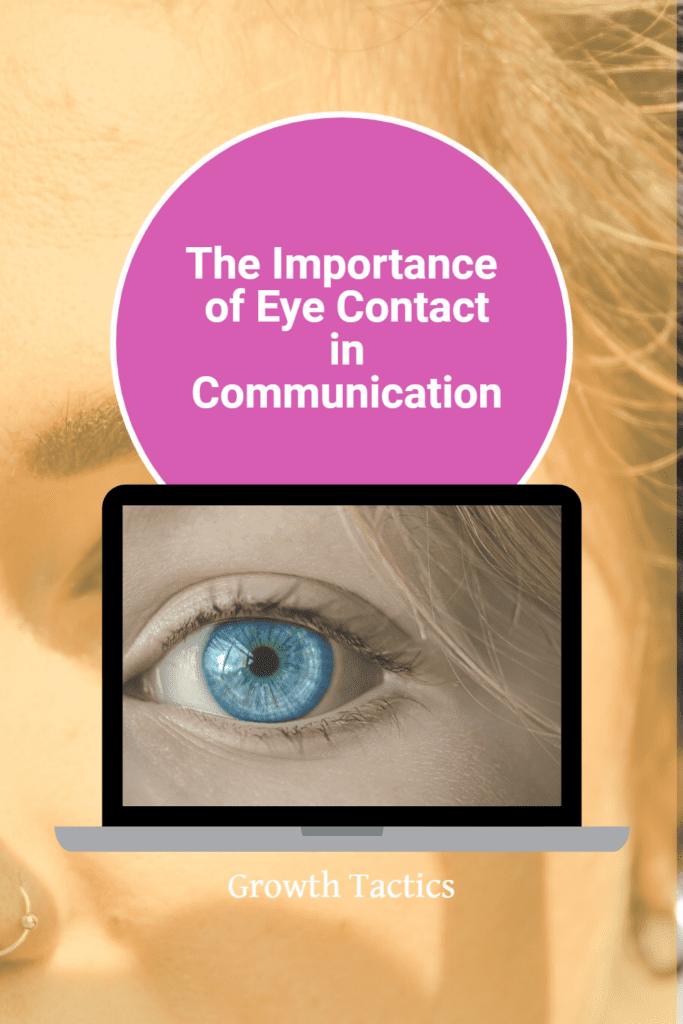Hey there! Have you ever noticed how powerful eye contact can be in a conversation? It’s amazing how a simple gaze can convey so much without saying a word. In this article, we’ll be diving deep into the world of eye contact and exploring why it’s such an important aspect of communication.
Jump To Section
Why is Eye Contact Important?
Let’s start by understanding why eye contact holds so much significance. Human beings are inherently social creatures, and eye contact plays a vital role in our day-to-day interactions. When we maintain eye contact, it signals to the other person that we are actively engaged in the conversation. It shows attentiveness and reinforces the connection between individuals.
Non-Verbal Communication and Eye Contact
Eye contact is an essential form of non-verbal communication. It complements the spoken word by conveying emotions, intentions, and cues. Our eyes have the power to express joy, sadness, curiosity, and many other emotions, often without us even realizing it. By using eye contact effectively, we enhance our ability to connect with others on a deeper level.
The Power of Eye Contact
One of the reasons eye contact is so powerful is because it helps establish trust and builds rapport. When someone looks directly into our eyes, it signals that they value and respect us. It’s a non-verbal way of saying, “You are important, and I am listening to you.” This simple act can make the person talking feel seen and heard, leading to a stronger bond between individuals.

How to Make Good Eye Contact
Now that we understand the importance of eye contact, let’s explore some practical tips on how to make good eye contact.
1. Maintain Eye Contact with the Person You Are Talking to
The most straightforward way to establish eye contact is to look directly into the other person’s eyes. When you’re engaged in a conversation, make an effort to focus on their eyes rather than looking around or being distracted. This shows that you are fully present and engaged in the conversation.
2. Use Eye Contact to Enhance Your Body Language
Eye contact goes hand in hand with other aspects of body language. By combining eye contact with appropriate facial expressions and gestures, you can amplify the impact of your communication. For example, maintaining eye contact while smiling conveys warmth and friendliness.
3. Strike a Balance: Not Too Little, Not Too Much
While eye contact is important, it’s essential to strike a balance. Avoid making too little eye contact, as it may come across as disinterest or lack of engagement. On the other hand, excessive eye contact can feel intense or intimidating. Aim for a comfortable and natural level of eye contact that matches the context and the person you are talking to.
The Benefits of Eye Contact in Communication
Now that we know how to make good eye contact, let’s explore some of the benefits it brings to our communication skills.
1. Enhances Interpersonal Communication
Eye contact is a key component of effective interpersonal communication. It fosters connection, builds trust, and promotes understanding between individuals. By using our eyes to communicate, we create a space for open and honest dialogue.
2. Improves Active Listening Skills
Maintaining eye contact with someone while they are speaking shows that you are actively listening. It lets the other person know that their words matter and that you are fully engaged in what they are saying. This level of attentiveness can lead to more meaningful conversations and stronger relationships.
3. Conveys Confidence and Self-Assuredness
When we make good eye contact, it signals confidence and self-assuredness. It shows that we are comfortable in our own skin and believe in what we are saying. This can have a positive impact on how others perceive us and can contribute to our overall presence in social settings.

The Science Behind Eye Contact in Communication: A Study
Have you ever wondered about the role of eye contact in communication and its impact on interpersonal relationships? An actual study conducted by psychology researchers may help shed some light on this question.
The study, published in the Journal of Personality and Social Psychology, aimed to explore the link between eye contact and feelings of connection or interpersonal closeness between individuals. In the study, participants were paired up and instructed to ask each other a series of personal questions while either making direct eye contact or looking away.
The results were insightful. The participants who maintained eye contact while asking and answering the personal questions reported feeling significantly closer and more connected to their partner than those who did not make eye contact. This finding highlights the importance of eye contact in influencing our perceptions of emotional connection and social closeness.
Additionally, the study sheds light on the neural mechanisms underlying the effects of eye contact. Brain-imaging techniques revealed increased activity in the ventromedial prefrontal cortex, a region associated with social cognition and interpersonal relationships, among those who maintained eye contact during the conversation.
This study is just one example of the many research findings that validate the power of eye contact in facilitating communication and building trust between individuals.
Cultural Differences in Eye Contact: How It Affects Communication
Have you ever noticed that eye contact norms differ from one culture to another? It’s fascinating to explore how something as seemingly simple as making eye contact can vary across different cultures. In this blog post, we’ll take a closer look at how eye contact varies across cultures and the impact it can have on communication. Understanding these cultural differences will give us a broader perspective and help us navigate cross-cultural interactions more effectively.
Eye Contact: Not a Universal Language
When it comes to eye contact, it’s essential to remember that cultural norms play a significant role in interpreting its meaning. In some cultures, maintaining direct and prolonged eye contact is considered a sign of respect, engagement, and honesty. On the contrary, in other cultures, prolonged eye contact may be seen as intrusive, disrespectful, or even confrontational. These differences highlight the importance of cultural context when deciphering the meaning behind eye contact.
High-Contact Cultures vs. Low-Contact Cultures
Cultural anthropologists often categorize cultures as high-contact or low-contact depending on their eye contact practices. High-contact cultures, like many Western cultures, tend to place a strong emphasis on maintaining direct eye contact during conversations. This is often seen as a way to convey interest, confidence, and trustworthiness. On the other hand, low-contact cultures, which include many Asian and Indigenous cultures, may place less emphasis on direct eye contact. They may view it as a sign of respect or humility, rather than as a sign of attentiveness.
The Impact on Cross-Cultural Interactions
Understanding these cultural differences is crucial when interacting with individuals from different backgrounds. Misinterpretations of eye contact can lead to misunderstandings or even offense. For example, in a cross-cultural business context, someone hailing from a high-contact culture may interpret a lack of eye contact from a person from a low-contact culture as disinterest or lack of trust, while it may simply reflect cultural norms.
Navigating Cross-Cultural Eye Contact
So, how can we navigate these differences in eye contact practices across cultures? The key is to remain aware and adaptable. If you find yourself in a cross-cultural interaction, observe the eye contact behavior of the person you are communicating with and follow their lead. If you’re unsure, it’s always acceptable to politely ask and seek clarification about the cultural expectations around eye contact.
Embracing Cultural Diversity
By acknowledging and understanding these cultural differences, we can cultivate respect for diverse communication styles. Embracing cultural diversity means recognizing that there is no universal right or wrong way to use eye contact. Instead, it’s about adapting to the cultural context, showing openness, and appreciating the richness that different perspectives bring to our interactions.
In Conclusion
Eye contact may seem like a simple gesture, but its impact in communication is profound. By making good eye contact, we can forge deeper connections, improve our listening skills, and convey confidence and respect. So, the next time you find yourself engaged in a conversation, remember the power of eye contact and use it to enhance your communication skills. Keep those eyes locked and watch the magic unfold!
Key Takeaways:
- Eye contact is an essential aspect of communication, conveying trust, attentiveness, and connection.
- Maintaining eye contact shows active listening and conveys confidence.
- Striking a balance is key – not too little, not too much.
- Eye contact enhances interpersonal communication and helps build stronger relationships.
- Remember the power of eye contact and use it to make your conversations more meaningful and impactful.
Now that you’ve learned the importance of eye contact, go out there and make those genuine connections with the power of your gaze!


